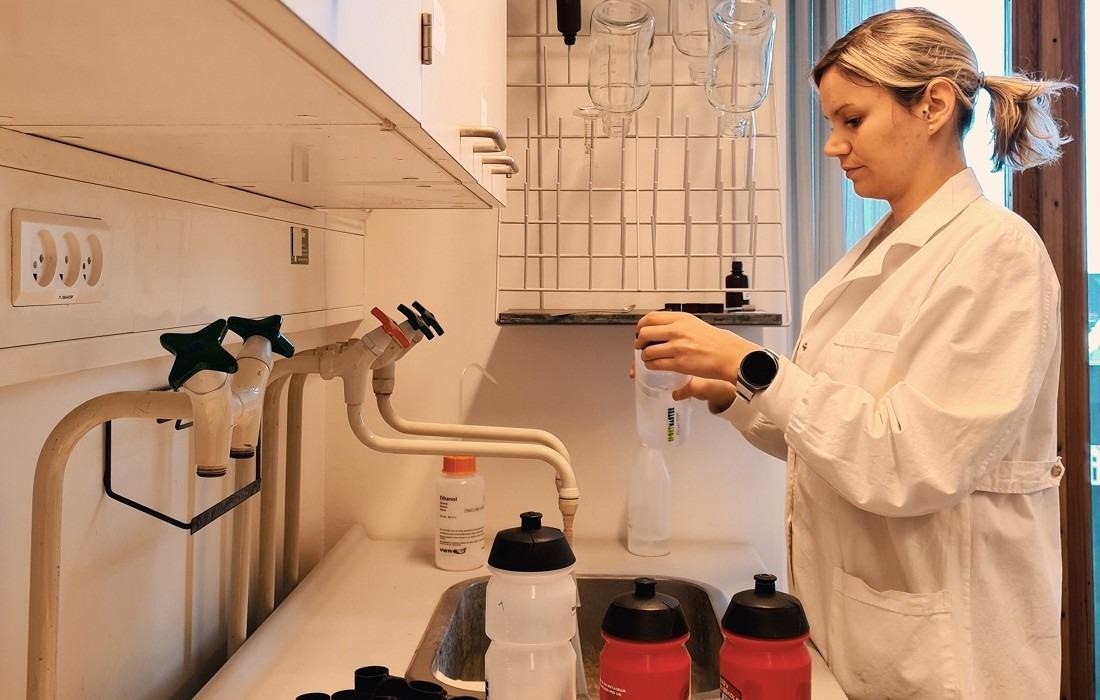University of Copenhagen Chemicals scientists have discovered several hundred different chemical elements in tap water that are found in reusable plastic bottles.
 Selina Tisler in the lab. Image Credit: University of Copenhagen
Selina Tisler in the lab. Image Credit: University of Copenhagen
A number of these elements are potentially detrimental to human health. There is a need for better directive and manufacturing protocols for manufacturers, according to the chemists involved in this study.
Water stored for a long time in a reusable plastic bottle tends to have a strange taste. There is a solid yet disturbing reason for this.
Two chemists from the University of Copenhagen have analyzed which chemical substances are discharged into liquids by commonly used soft plastic reusable bottles. The findings were quite a shock.
We were taken aback by the large amount of chemical substances we found in water after 24 hours in the bottles. There were hundreds of substances in the water—including substances never before found in plastic, as well as substances that are potentially harmful to health. After a dishwasher cycle, there were several thousand.
Jan H. Christensen, Professor of Environmental Analytical Chemistry, Department of Plant and Environmental Sciences, University of Copenhagen
Endocrine Disruptors and Insecticide
Professor Christensen and fellow scientist Selina Tisler identified over 400 different substances from the bottle plastic and more than 3,500 substances extracted from dishwasher soap. A huge portion of these substances are yet to be identified by the scientists. But even of the recognized chemicals, the toxicity of nearly 70% remains unidentified.
Photo-initiators are among the deadly substances in the water which worry the scientists. These are said to have possible harmful effects on health in organisms, such as being carcinogens and endocrine disruptors.
Moreover, the scientists discovered a range of plastic softeners, antioxidants and release agents used in the making of the plastic, as well as diethyltoluamide (DEET), commonly known as the active substance in mosquito spray.
Machine Washing Adds More Substances into the Bottled Water
In their experiments, the researchers simulated the ways in which many people normally use plastic drinks bottles. People frequently drink water that has been stored in bottles for many hours. The scientists filled ordinary tap water in both used and new drinking bottles for 24 hours, both before and after machine washing, as well as after the bottles had been in the dishwasher and washed really well in tap water.
What is released most after machine washing are the soap substances from the surface. Most of the chemicals that come from the water bottle itself remain after machine washing and extra rinsing. The most toxic substances that we identified actually came after the bottle had been in the dishwasher—presumably because washing wears down the plastic and thereby increases leaching,
Selina Tisler, Postdoctoral Researcher and Study First Author, Department of Plant and Environmental Sciences, University of Copenhagen
In the new reusable bottles, nearly 500 different substances were found in the water after an extra rinse. The plastic itself was the source for more than 100 of these substances.
She stresses that they are still to conclude whether the water in the bottles is injurious to health, as they presently have only an estimate of the concentrations of the substances and toxicological evaluations are still under way.
“Just because these substances are in the water, doesn't mean that the water is toxic and affects us humans. But the problem is, is that we just don't know. And in principle, it isn’t all that great to be drinking soap residues or other chemicals," says Selina Tisler.
"From now on, I'll use a glass bottle"
We care so much about low levels of pesticides in our drinking water. But when we pour water into a container to drink from, we unflinchingly add hundreds or thousands of substances to the water ourselves. Although we cannot yet say whether the substances in the reusable bottles affect our health, I’ll be using a glass or quality stainless steel bottle in the future.
Jan H. Christensen, Professor of Environmental Analytical Chemistry, Department of Plant and Environmental Sciences, University of Copenhagen
The scientists feel that bottle manufacturers only deliberately incorporate a small amount of the substances found. The majority have unintentionally occurred either during the manufacturing process or during use, where substances may have been formed from other substances.
This includes the occurrence of the mosquito repellent DEET, where the scientists hypothesize that as one of the plastic softeners breaks down, it is turned into DEET.
"But even of the known substances that manufacturers deliberately add, only a tiny fraction of the toxicity has been studied. So, as a consumer, you don't know if any of the others have a detrimental effect on your health," says Selina Tisler.
Too little knowledge, too leniently regulated
According to the researchers, the results reflect a lack of both knowledge and regulation:
"The study exemplifies how little knowledge there is about the chemicals emitted from the products that our food and drink come in contact with. And, it is a general problem that measurement regulations during production are very lenient. Fortunately, both in Denmark and internationally, we are looking into how to better regulate this area," says Jan H. Christensen.
Meanwhile, Selina Tisler hopes that companies will be responsible on their own.
Hopefully, companies that put their names on reusable plastic bottles will be more careful about the products they purchase from suppliers and perhaps place greater demands on suppliers to investigate the substances found in what they manufacture.
Selina Tisler, Postdoctoral Researcher and Study First Author, Department of Plant and Environmental Sciences, University of Copenhagen
The study results are published in the scientific journal Journal of Hazardous Materials.
Journal Reference:
Tisler, S., & Christensen, J.H., (2022) Non-target screening for the identification of migrating compounds from reusable plastic bottles into drinking water. Journal of Hazardous Materials. doi.org/10.1016/j.jhazmat.2022.128331.